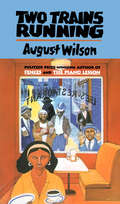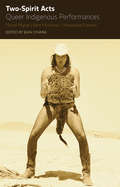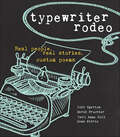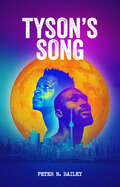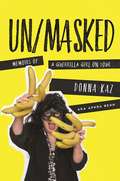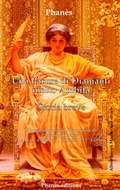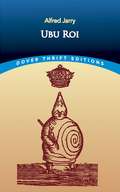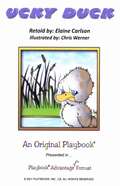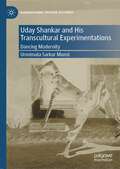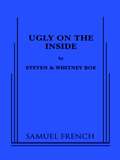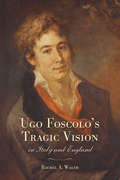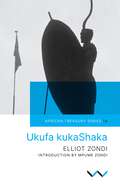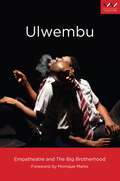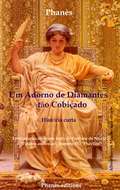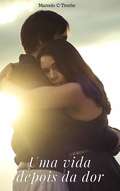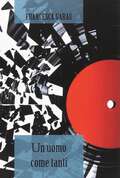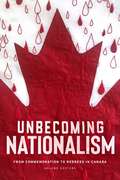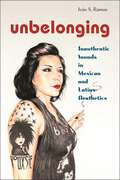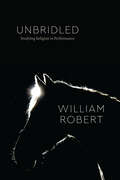- Table View
- List View
Two Trains Running: 1969 (Drama, Plume Ser.)
by August WilsonFrom the Pulitzer Prize-winning author of Fences and The Piano Lesson comes a “vivid and uplifting” (Time) play about unsung men and women who are anything but ordinary. August Wilson established himself as one of our most distinguished playwrights with his insightful, probing, and evocative portraits of Black America and the African American experience in the twentieth century. With the mesmerizing Two Trains Running, he crafted what Time magazine called “his most mature work to date.” It is Pittsburgh, 1969, and the regulars of Memphis Lee’s restaurant are struggling to cope with the turbulence of a world that is changing rapidly around them and fighting back when they can. The diner is scheduled to be torn down, a casualty of the city’s renovation project that is sweeping away the buildings of a community, but not its spirit. For just as sure as an inexorable future looms right around the corner, these people of “loud voices and big hearts” continue to search, to father, to persevere, to hope. With compassion, humor, and a superb sense of place and time, Wilson paints a vivid portrait of everyday lives in the shadow of great events.
Two Wives and a Dead Guy
by Cynthia BoothComedy / 3m, 2f / Interior / Mr. Donald Howard Becton III, the successful globe-trotting businessman and millionaire, is deader than a pair of socks. And he is presently on display for the world to see at the Olson-Hines Funeral Home. His wife, the educated and well-pedigreed Eileen, visits, and puts on a good show to get that nervous, rat terrier of a junior funeral hall director in training, Mr. Hines, to leave her alone with the corpse. Unfortunately, Eileen has a problem. No, not the pyromaniac daughter nor the bedwetting son; no, no one can find Becton's will, not even his golf-obsessed lawyer knows where it is. Perhaps clues to the dilemma can be found on the corpse? But, before a proper search can be made, Veronica shows up, a gaudily painted, silicone enhanced "lady" who also claims to be Becton's wife. Let's just say that that is not what Eileen expected. The two immediately despise each other and eventually go at it to hilarious means, leaving behind a very perplexed Mr. Hines (and one very battered corpse) at play's end.
Two-Spirit Acts: Queer Indigenous Performances
by Jean O'Hara Waawaate Fobister Muriel Miguel Kent MonkmanWith a refreshing spin, the plays touch on topics of desire, identity, and community as they humorously tackle the colonial misunderstandings of Indigenous people. From a female trickster story centred on erotic lesbian tales to the farcical story about a new nation of Indigenous people called the Nation of Mischief, this collection creates a space to explore what it means to be queer and Indigenous.
Typewriter Rodeo: Real People, Real Stories, Custom Poems
by Jodi EgertonBoth a visual feast and a reference book in the style of Brandon Stanton&’s Humans of New York, Typewriter Rodeo collects custom, typewritten poems from &“rodeos&” worldwide, portraits of recipients, and their personal stories. Typewriter Rodeo began in Austin, Texas, when four poets brought their typewriters to a maker fair and began offering spontaneous, custom-composed poems to an enthusiastic crowd. The event quickly blossomed and rodeos began popping up all over the world.
Tyrant: Shakespeare On Politics
by Stephen GreenblattWorld-renowned Shakespeare scholar Stephen Greenblatt explores the playwright’s insight into bad (and often mad) rulers. As an aging, tenacious Elizabeth I clung to power, a talented playwright probed the social causes, the psychological roots, and the twisted consequences of tyranny. In exploring the psyche (and psychoses) of the likes of Richard III, Macbeth, Lear, Coriolanus, and the societies they rule over, Stephen Greenblatt illuminates the ways in which William Shakespeare delved into the lust for absolute power and the catastrophic consequences of its execution. Cherished institutions seem fragile, political classes are in disarray, economic misery fuels populist anger, people knowingly accept being lied to, partisan rancor dominates, spectacular indecency rules—these aspects of a society in crisis fascinated Shakespeare and shaped some of his most memorable plays. With uncanny insight, he shone a spotlight on the infantile psychology and unquenchable narcissistic appetites of demagogues—and the cynicism and opportunism of the various enablers and hangers-on who surround them—and imagined how they might be stopped. As Greenblatt shows, Shakespeare’s work, in this as in so many other ways, remains vitally relevant today.
Tyson's Song
by Peter N. BaileyBest friends Bryan and Tyson are out for a night in Toronto before Bryan leaves for Vancouver in the morning. But when they miss the late-night bus with a six-pack in tow, everything the two men have bottled up about their friendship starts pouring out—like Bryan’s struggles as a husband and father or Tyson’s volatile outbursts since he got out of prison. As their moonlit vigil unfolds and an ominous police cruiser circles nearby, the ramifications of Bryan’s departure become heartbreakingly clear. Can they save their relationship—and maybe even their lives—before the next bus arrives?Peter N. Bailey’s powerful debut illuminates the complex dynamics of Black masculinity and brotherhood in a world that too often denies Black men love, compassion, and care. A catalyst for vital conversations about men’s mental health, Tyson’s Song is a tender portrait of two souls in limbo and a rallying cry for a new kind of conversation—one born of trust and the courage to lay bare our humanity.
UN/MASKED: Memoirs of a Guerrilla Girl on Tour
by Donna KazUN/MASKED, Memoirs of a Guerrilla Girl On Tour! follows the surprising 25 year journey of a young, New York City actress swept off her feet by a rising movie star who carries her to Malibu and back for a three-plus year love affair that is both fantastical and physically dangerous. When Nicole Brown Simpson and Ron Goldman are murdered in Brentwood she hears a bell go off, awakening her angry, activist spirit. Always an outsider, she takes one step further into invisibility and becomes a Guerrilla Girl, a feminist activist who never appears in public without wearing a rubber gorilla mask and who uses the name of a dead woman artist instead of her own. As a Guerrilla Girl, Aphra Behn creates comedic art and theater that blasts the blatant sexism of the theater world while proving feminists are funny at the same time.These two narratives-that of a young victim of domestic violence at the hands of a successful film actor and that of an artist so fed up with sexism in the theater world that she puts on a gorilla mask and takes the name of a dead woman artist to provoke change-have been lived by one woman. Donna Kaz offers her compelling firsthand account-illuminated by more than thirty behind-the-scenes photographs, stickers and posters -of her transition from a silent observer to an unapologetic activist.This is the memoir of a woman-turned-survivor-turned-radical-feminist who takes off her mask and, by merging her identities, reveals all.
UNA PARURE DI DIAMANTI MOLTO AMBITA
by Patrice Martinez Monica OzelloUna parure di diamanti può nascondere sordidi segreti, e questi non sono sempre sotto buoni auspici.. Spesso ritroviamo in una famiglia dei gioielli di "grande valore" che si tramandano da una generaazione all'altra. Ma in una casa borghese della bella Atene un regalo di valore inestimabile causerà non pochi tormenti al suo proprietario, un ricco commerciante ateniese. Una parure di diamanti può nascondere sordidi segreti, e questi non sempre sono sotto buoni auspici... "Una poarure di diamanti molto ambita" è un adattamento del libro di Partenio di Nicea "Le pene d'amore" numero 25: "Faillo"
Ubhuku Lwamanqe: UEB Contracted
by E J MhlangaLena yincwadi yomdlalo okusetshenziswe kuwo abalingiswa abazithola bebhekene nezinkinga nengcindezi kanye nezinselelo zempilo yobugebengu obuhleliwe okwenza balokhu bebisha kancane kancane emsingeni olubhuku lwamanqe ukuze ekugcineni kuzuze wona. Okuhlala obala ukuthi laba balingiswa basuka bengaboni ukuthi izinyosi zidla uju lwazo baphinde bakhohlwe ukuthi kalikho iqili elazikhotha emhlane kanti yonke imfihlo empilweni inendlela evela ngayo nangemuva kweminyakanyaka leso sigameko senzeka. Zifundele mfundi ukuze ukwazi ukuzihlaziyela ngezinqumo abazithathayo ezigcina ngakho ukubagqiba kumlindashoba wezingqinamba zempilo. Yibhuku eliqukethe: • Izidingo nezindlela ezilula zokuhlaziya umdlalo. • Umlando mpilo wombhali. • Imibuzo yokuhlolwa okumiselwe imigomo nezimpendulo ngokulandela izidingo ze-CAPS. • Ngumdlalo olungele amabanga emfundo aphakeme.
Ubhuku Lwamanqe: UEB Uncontracted
by E J MhlangaLena yincwadi yomdlalo okusetshenziswe kuwo abalingiswa abazithola bebhekene nezinkinga nengcindezi kanye nezinselelo zempilo yobugebengu obuhleliwe okwenza balokhu bebisha kancane kancane emsingeni olubhuku lwamanqe ukuze ekugcineni kuzuze wona. Okuhlala obala ukuthi laba balingiswa basuka bengaboni ukuthi izinyosi zidla uju lwazo baphinde bakhohlwe ukuthi kalikho iqili elazikhotha emhlane kanti yonke imfihlo empilweni inendlela evela ngayo nangemuva kweminyakanyaka leso sigameko senzeka. Zifundele mfundi ukuze ukwazi ukuzihlaziyela ngezinqumo abazithathayo ezigcina ngakho ukubagqiba kumlindashoba wezingqinamba zempilo. Yibhuku eliqukethe: • Izidingo nezindlela ezilula zokuhlaziya umdlalo. • Umlando mpilo wombhali. • Imibuzo yokuhlolwa okumiselwe imigomo nezimpendulo ngokulandela izidingo ze-CAPS. • Ngumdlalo olungele amabanga emfundo aphakeme.
Ubu Roi: Drame En Cinq Actes En Prose, Restitute En Son Integrite Tel Qu'il A Ete Representee Par Les Marionnettes Du Theatre De L'oeuvre Le 10 Decembre 1896, Avec La Musique De Claude Terrasse (Dover Thrift Editions Ser.)
by Alfred JarryWhen it first opened in Paris in late 1896, Ubu Roi immediately outraged audiences with its scatological references and surrealist style. Spectators rioted during the premiere (and final) performance and unrelenting controversy over the play's meaning followed. The quality and stunning impact of the work, however, was never questioned.Early drafts of the play were written by Jarry in his teens to ridicule one of his teachers. The farce was done in the form of stylized burlesque, satirizing the tendency of the successful bourgeois to abuse his authority and become irresponsibly complacent. Ubu -- the cruel, gluttonous, and grotesque main character (the author's metaphor for modern man) -- anticipated characteristics of the Dada movement. In the 1920s, Dadaists and Surrealists championed the play, recognizing Ubu Roi as the first absurdist drama.
Ucky Duck
by Chris Werner Elaine CarlsonWelcome to the world of Playbooks® and the beginning of a wonderful role-play reading adventure! Playbook® stories are presented in a unique and colorful format and are read out loud by several readers like a play, without memorization, props, or a stage. <p><p>When you read a Playbook®, you and other readers bring the story to life and become the characters. As you read your part out loud, you will have fun expressing and acting like your character. You and the other readers will explore the story plot together and learn what will happen next. It's an exciting journey of discovery that pulls you into the story, and you'll want to read it out loud again and again!
Uday Shankar and His Transcultural Experimentations: Dancing Modernity (Transnational Theatre Histories)
by Urmimala Sarkar MunsiThis monograph presents a specific experience of modernity within the context of Indian dance by looking at the transcultural journey of Indian dancer / choreographer Uday Shankar (1900b – 1977d). His popularity in Europe and America as an Oriental male dancer in the first half of the 20th century, and his worldwide recognition as the Ambassador of Indian culture, are brought into a historiographical perspective within the cultural and social reforms of early twentieth century India. By exploring his artistic journey beyond India in the period between the two world wars, and his experience of dance making, presentational technique and representation of India through various phases of his life, a path is forged to understanding the emergence of modernity in Indian dance.
Ugly on the Inside
by Steven BoeComedy / 1m., 2f. / Exterior / Della has always dreamed of the perfect life: a springtime wedding in Vegas, a litter of kids running around the trailer, and a husband... any husband. Her best friend, Rayanne, only wants the best for Della but she has a habit of "accidentally" murdering Della's fiancés. Now, on her sixth (or is it her seventh?) wedding day, Della's latest groom, Charlie, has wound up on the floor with a cake knife in his gut. The two women load Charlie's body into his pickup truck and drive into the desert to bury him but soon discover it's hard to keep a bad man down. / "There's something more to Ugly on the Inside than the quirky comedy that appears on the surface..." - Dalton Dicky, Filmthreat.com
Ugo Foscolo's Tragic Vision in Italy and England
by Rachel A. WalshOne of the most celebrated Italian writers of the early Romantic period, Ugo Foscolo (1778-1827) was known primarily as a novelist, a poet, and a nationalist. Following the Napoleonic Wars, he lived in self-exile in England during the last decade of his life. There he wrote numerous critical essays and collaborated with Lord Byron and other well-known members of English literary circles.Ugo Foscolo's Tragic Vision in Italy and England examines an underexplored aspect of Foscolo's literary career: his tragic plays and critical essays on that genre. Rachel A. Walsh argues that for Foscolo tragedy was more than another genre in which to exercise his literary ambitions. It was the medium for an elaborate life-long process of self-examination and engagement with political and literary conflict. By analysing Foscolo's tragic struggles on and off the stage, Walsh sheds new light on his career and how it reflects on the important literary and political trends of the time.
Ukufa kukaShaka
by Elliot ZondiUkufa kukaShaka is a historical drama by Elliot Zondi, first published in 1960 in the Bantu (later, African) Treasury Series by the University of the Witwatersrand Press. Its plot is based on the events surrounding the assassination of Shaka, the mighty Zulu king, by his two half-brothers, Dingane and Mhlangana, aided and abetted by his paternal aunt, Mkabayi, in 1828. The play explores the classic theme of the tragic hero’s fatal flaws: hubris and overconfidence. Shaka’s ruthless ambition led him to overstep human boundaries, kill with impunity, bar his warriors from having families and force them into endless wars. His blind spot seems to have been to put the survival and expansion of the Zulu kingdom first and the welfare of his subjects second.Against this backdrop Mkabayi, whose ambitions for a remarkable Zulu nation were more tempered, played a decisive role in his downfall. Zondi explores arguments both in favor of and against Shaka’s assassination in a way that allows the reader to sympathize with his greater vision and his thwarted plan to fight impending colonialism. His dramatization of the conflict between Shaka and Mkabayi highlights questions of leadership and nation-building that continue to be relevant today.
Ulwembu: A play
by Empatheatre The Big BrotherhoodAn empathetic theatrical journey through the spider's web of addictionDanger stalks the township of KwaMashu, near Durban. It comes in the form of whoonga (known as nyaope elsewhere), a toxic mix of B-grade heroin, rat poison and other chemical components that almost immediately sucks its users into a vortex of addiction and the crime, deception and personal tragedy that goes with it. Caught up in the web, the ulwembu of the title (spider’s web in isiZulu), presided over by the dealer, Bongani Mseleku, are Lieutenant Portia Mthembu, a police officer in the frontline of the fight against the scourge; her son Sipho; his friend, Andile Nxumalo, and Emmanuel Abreu, a Mozambique-born spaza shopkeeper. As it traces Sipho’s descent from talented scholar and aspirant poet and songwriter to suicidal addict, Ulwembu explores the effects of addiction not only on those who suffer from it but on communities, families and the police, both those who try to control the murderous trade and those who benefit from it. Using a process they have dubbed Empatheatre, The Big Brotherhood, Neil Coppen, Dylan McGarry and Mpume Mtombeni, aim to share ‘people’s real-life stories, with the intention to inspire and develop a greater empathy and kindness in spaces where there is conflict or injustice’. Ulwembu is the dramatic result of their efforts.
Um adorno de diamantes tão cobiçado
by Patrice Martinez Helaíne H S MachadoNós encontramos, frequentemente, dentro de uma família, joias de "grande valor" que passam de uma geração a outra. Mas em uma casa burguesa da bela Atenas, um presente de custo inestimável vai causar muitos tormentos ao seu proprietário, um rico comerciante ateniense. Um adorno de diamantes pode esconder pesados segredos, e estes nem sempre são postos sob felizes auspícios... "Um adorno de diamantes tão cobiçado" é uma adaptação livre de Partênio de Niceia: "Paixões amorosas", número 25: "Phayllos".
Uma Vida depois da Dor
by Ana Paula Ruth Lima Marcelo C Troche"Eu acredito que a vida é a melhor oportunidade de ser você mesmo, ser leal e livre, mesmo vivendo em uma sociedade onde você deve seguir regras, onde você deve ter valores e onde, às vezes, você não pode se revelar e seguir seus ideais. A vida é a expressão e a liberdade de voar como um pássaro e de seguir sua própria luz, sua própria estrela. Eu acho que você tem a oportunidade de selecionar aqueles que oferecem amor e que também recebem. Lembre-se que você é único e que a pessoa que quer estar ao seu lado não deve ser ferida, não deve ser mudada, não deve quebrar suas asas, ou parar seu vôo e claro que você não deveria. Pelo contrário, os pássaros que voam juntos, aprendem a conviver, aprendem a se entender e a encontrar estratégias para chegar ao seu destino. Além disso, a solidão e a dor fazem parte desse processo que chamamos de viver, dão-lhe aprendizagens, elas mudam você, lembram-lhe o quanto você é forte para continuar lutando; Eles nos lembram de quão vulneráveis e fracos às vezes nos tornamos, mas quão invencíveis e perseverantes podemos nos tornar. Pinte uma imagem da sua vida, visualize onde você está e aonde você quer ir. Analise, se você está dando os passos certos, se você está no lugar certo e com as pessoas certas. Se não é assim e você precisa de uma mudança, faça agora porque a vida é hoje, e você pode ir com a passagem do tempo, ou no momento em que menos espera."
Un enemigo del pueblo
by Henrik Ibsen"Nunca debe usted usar sus mejores pantalones cuando vaya a luchar por la libertad y la verdad" (Un enemigo del pueblo) Henrik Ibsen creó una obra dramática de enorme contenido psicológico y de una ideología profunda. Fue un iniciador en el arte dramático y representante de una época nueva siendo el creador del llamado "teatro de ideas" y del "teatro simbólico". Lla obra de Ibsen se puede considerar como la más influyente del siglo XX en el campo del drama. Sus trabajos se representan continuamente en los países civilizados y se han adaptado al cine y a la televisión innumerables veces.
Un hombre como tantos: Un uomo come tanti
by Tomás PoetaPara Greta Moore, el cantante William Stevenson lo es todo. Lo sigue desde que era una niña, colecciona sus discos y, por ese fanatismo, termina descubriendo la verdad que se oculta en las letras de sus canciones. Cuando Greta gana una subasta benéfica que le permite conocer a su ídolo, ella decide revelarle sus descubrimientos, creyendo que, a partir de ese momento, su vida ordinaria daría un vuelco y encontraría la verdadera felicidad. Pero desde entonces, tanto la vida de William como la de Greta se verán envueltas en una aventura de vida… o muerte.
Una parte del mal
by Ramón de la VegaDos parejas cuyos destinos se entrecruzan en una obra rápida, de diálogos afilados y con la ambición de dejar un mensaje. Una obra de estructura clásica, pero de tema profundamente moderno, de esa modernidad en la que se reconoce que nuestros placeres y tragedias se mantienen hoy como un eco inagotable de lo que vivieron, muchas veces con sorpresa o estupor, otros hombres y mujeres de otras épocas. <P><P>El mal es el protagonista de la obra o, más exactamente, «el pequeño mal», por utilizar las palabras de uno de los protagonistas; en este caso Carmen, una joven comprometida y necesitada de justificaciones más altas, pero que, en el momento de concluir el libro, está a punto de quedar atrapada por aquel al que se opuso, por el único personaje que, en la obra, representa abiertamente la manifestación cotidiana del mal.
Unbecoming Nationalism: From Commemoration to Redress in Canada
by Helene VostersCanada’s recent sesquicentennial celebrations were the latest in a long, steady progression of Canadian cultural memory projects. Unbecoming Nationalism investigates the power of commemorative performances in the production of nationalist narratives. Using “unbecoming” as a theoretical framework to unsettle or decolonize nationalist narratives, Helene Vosters examines an eclectic range of both state-sponsored social memory projects and counter-memorial projects to reveal and unravel the threads connecting reverential military commemoration, celebratory cultural nationalism, and white settler-colonial nationalism. Vosters brings readings of institutional, aesthetic, and activist performances of Canadian military commemoration, settler-colonial nationalism, and redress into conversation with literature that examines the relationship between memory, violence, and nationalism from the disciplinary arenas of performance studies, Canadian studies, critical race and Indigenous studies, memory studies, and queer and gender studies. In addition to using performance as a theoretical framework, Vosters uses performance to enact a philosophy of praxis and embodied theory.
Unbelonging: Inauthentic Sounds in Mexican and Latinx Aesthetics (Postmillennial Pop #28)
by Iván A. RamosHow Latinx artists engage in sonic subcultures to reject neoliberal definitions of belongingWhat is the connection between the British rock star Morrissey and the Latinx culture of transnational “unbelonging”? What is the relevance of “dyke chords” in Chicana feminist punk and lesbian dissolution? In what ways can dissonant sounds challenge systems of dominance?Unbelonging answers these questions and more through an exploration into Mexican and US-based Latinx artists’, writers’, and creators’ use of the discordant sounds of punk, metal, and rock to give voice to the aesthetic of “unbelonging,” a rejection of consumerist and nationalist mentalities. Iván A. Ramos argues that racial identity and belonging have historically required legible forms of performance. Sound has been the primary medium that amplifies and is used to assign cultural citizenship and, for Latinx individuals, legibility is essential to music perceived as traditional and authentic to their national origins. In the context of twentieth-century neoliberal policies, which cemented the concept of “citizen” within logics of consumerism and capitalism, Ramos turns to focus on Latinx artists, writers, and audiences, who produce experimental and often “inauthentic” performances and installations in sonic subcultures to reject new definitions of economic citizenship.Organized around studies of a number of artists, all whom are explored through the methodological frameworks of sound studies, performance studies, and queer theory, Unbelonging unearths how their very different genres of music share a unifying theme of dissonance. With the backdrop of neoliberalism’s attempt to define citizenship in relation to economic and cultural legibility, Unbelonging offers an urgent analysis of how these oft-overlooked queer and feminist performers and fans used sonic illegibility to challenge gender norms, official definitions of citizenship, and narratives of assimilation. Ultimately, these forms of inauthenticity move beyond negation and become ways to imagine alternative realities.
Unbridled: Studying Religion in Performance (Class 200: New Studies in Religion)
by William RobertA study of religion through the lens of Peter Shaffer’s play Equus. In Unbridled, William Robert uses Equus, Peter Shaffer’s enigmatic play about a boy passionately devoted to horses, to think differently about religion. For several years, Robert has used Equus to introduce students to the study of religion, provoking them to conceive of religion in unfamiliar, even uncomfortable ways. In Unbridled, he is inviting readers to do the same. A play like Equus tangles together text, performance, practice, embodiment, and reception. Studying a play involves us in playing different roles, as ourselves and others, and those roles, as well as the imaginative work they require, are critical to the study of religion. By approaching Equus with the reader, turning the play around and upside-down, Unbridled transforms standard approaches to the study of religion, engaging with themes including ritual, sacrifice, worship, power, desire, violence, and sexuality, as well as thinkers including Judith Butler, Sigmund Freud, Karl Marx, Friedrich Nietzsche, and Jonathan Z. Smith. As Unbridled shows, the way themes and theories play out in Equus challenges us to reimagine the study of religion through open questions, contrasting perspectives, and alternative modes of interpretation and appreciation.
